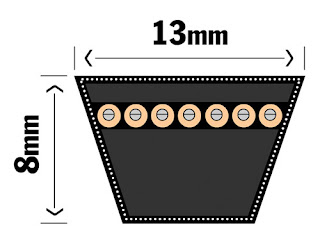This blog is set V-Belts. The thing describes the constructional factors of V-Belts, the varieties of V- Belts and their advantages and drawbacks.
We could us begin with a simple query. How will we transmit rotary strength from one location to every other? Well, we have several solutions and one of the answers might virtually be a V-Belt. A simple way of defining any belt force could be imagining two separate rollers being sure through a thread that runs over its outer edge. The thread acts as the power transmitter conveying electricity from the motive force member to the pushed member. Within the actual V-Belt drive machine, the thread is the V-Belt and the rollers are known as pulleys.
Concept of V-belt
 |
V-Belt - A Section |
V-Belts are the friction based strength or torque transmitters. The power is transmitted from one pulley to the alternative by means of the friction among the belt and pulley. The rubber used as the base cloth plays a totally crucial role in this. This is quite just like the friction between the Tyre and road within the cars that permits the motors to move on the road.
The V-Belt is called so because of its move section. The moving segment of a V-Belt is similar to that of the letter ‘V’. Allow us to know check out the constructional aspects of the V-Belt. The V- Belt includes the subsequent
V-Belt production
- Metallic Wires: The wires are of a limitless kind having no joints in them. They provide the necessary reinforcement and strength to the V-Belt for transmission of the torque.
- Base Rubber Compound: The wires are surrounded through a special rubber compound providing shape to the V-Belt. The compound also acts as a compression medium to absorb the shocks during power transmission.
- Defensive cover: the protective cowl is largely a layer of plastic which provides endurance for the rubber against the high temperature that is generated at some point of the movement of the V-belt.
Dimensions of V-belt
Our classical V-Belts have been designated to be used with V-Belt pulleys according to DIN2217 or DIN2211
ISO 4184
|
Z
|
A
|
B
|
C
|
DIN 2215
|
10
|
13
|
17
|
22
|
Section W x H (mm)
|
10 x 6
|
13 x 8
|
17 x 11
|
22 x 14
|
Datum Width (mm)
|
8.5
|
11
|
14
|
19
|
Belt Weight per meter (kg/m)
|
0.05
|
0.12
|
0.19
|
0.32
|
Min. Pulley Diameter (mm)
|
50
|
75
|
125
|
200
|
Max. Flexing Frequency (S -1)
|
70
|
70
|
70
|
70
|
Max. Belt Speed (m/s)
|
30
|
30
|
30
|
30
|
Min. Length (mm)
|
330
|
356
|
483
|
737
|
Max. Length (mm)
|
3000
|
10000
|
15000
|
15240
|
Length Conversion - Lp to La (mm)
|
16
|
14
|
26
|
32
|
Length Conversion - Li to Lp (mm)
|
22
|
36
|
43
|
56
|
Length Conversion - Li to La (mm)
|
38
|
50
|
69
|
88
|
Advantages of V-Belts
- They transmit higher torque with lesser width and anxiety compared to the different type of belts.
- They can be utilized in regions with very less arc of contact of the belt.
- They may be operated in speeds ranging among 5 to 30 m/sec
The drawback of the V-belt is that because of the wedging movement of the belt and extended bending and windage losses the efficiency of the belt is about three% lesser than the alternative form of belts. Apart from this the belt does have the tendency to slide at high loads and receives effortlessly damaged for the duration of slipping.

No comments:
Post a Comment